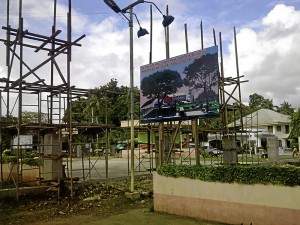Is the plaza of any value today?
Value? Not for some mayors and municipal officials, especially those of Antequera in Bohol and San José in Batangas, who are being questioned by their constituents for constructions in the town plazas.
Another controversy in the making is the unannounced appearance of construction workers at the historic rotonda of the Heritage City of Carcar in Cebu. The workers are reported to be doing some “repair” work on the heritage kiosk symbolic of Carcar.
City officials and local heritage groups, unaware of the activity, are said to have not approved any intervention on the Carcar rotonda, a site protected by the 2005 Carcar Heritage Ordinance.
Antequera in Bohol has a different story.
The town needed a multipurpose building, so officials decided to build it in the town plaza despite a loud outcry from Antequerahanons here and abroad. While a multipurpose building, they said, is a good thing that Antequera needs, couldn’t it be built somewhere else, so the plaza could remain as it is?
It couldn’t be built anywhere else, answered the mayor and town officials.
The prefabricated steel structure for the Multi-Purpose Building was delivered. On-site adjustments in the structure had to be made because the prefabricated structure’s dimensions went over property boundaries.
But the construction on the P7-million structure proceeded, and still continues despite a case filed to stop construction. So what happens now?
In San José, Batangas, concerned residents attended a recent Municipal Development Council meeting to deliberate on the proposal of the mayor to construct a new municipal hall in the plaza.
Reportedly presented at the meeting was the result of an inquiry made to the National Historical Commission of the Philippines, whose chair wrote:
“For the kind information of the honorable mayor, historic town plazas like this one in San José, Batangas, should remain open and green to serve as a breathing space of the town. Its open area should not be diminished, and its land use and zoning category should not be converted or changed.
“Moreover, town plazas are places where townspeople congregate for various activities, and therefore should be regarded as a natural environment and space that relates to the history of the town and the lifestyle of its community.”
Despite being aware of the response of NHCP chair Maria Serena Diokno, the Municipal Development Council voted to build the new municipal hall in the plaza.
The Sadiwa Multipurpose Cooperative of San José is criticizing the decision of the municipal government to push through the building.
Heartbeat
Plazas, which in the Philippines follows the classic Spanish town planning (hence, Madrid’s Plaza Mayor), are the centers of urban places, an open green space where people gather for ceremonial or recreational purposes, the town’s shared outdoor living room where everybody comes together and communal activities, such as the yearly fiesta, happen.
The plaza tradition cuts across cultures.
In English culture, it is a shared open space in the center of towns, called the village green or commons, a name rooted in the agricultural origins of villages.
Italian piazzas bring the outdoor-living-room tradition to the fullest. People crowd rural and urban piazzas, have drinks at the village bar and dinner at the village ristorante, and spend the evening mingling with friends and neighbors.
In China, the main square is a large open space where people gather constantly. Early in the morning, there are tai-chi groups, calisthenics, joggers and people doing morning exercises. Later in the day, children come to play; school groups use the square for dance or acrobatic practice.
Kites fly all day. Late afternoons fill the park with more residents who abandon cramped apartments for the open air. In leafy precincts at the edges of the park-like square, groups of elderly gather to ballroom-dance.
Plazas are essential for urban spaces. They are escape valves that relieve the pressures of urban living, provide a place for residents to socialize and feel part of the community, and it is where political or religious public gatherings happen.
Plazas are urban spaces that reinforce the quality of life for residents. For that reason, they are important to keep.
To be able to keep them, there is a need for dialogue between concerned citizens and government authorities, a straightforward, unemotional dialogue based on facts:
What are the points of view and rationale for the choice of building site? Are there any alternatives? There may be a need to organize a forum between citizens and local government on heritage, its benefits and rewards.
Most important is providing some wiggle room for each party to be able to come to realizations or compromises while maintaining one’s dignity.
Shouldn’t protecting heritage be a win-win situation?
Feedback is welcome at pride.place@gmail.com